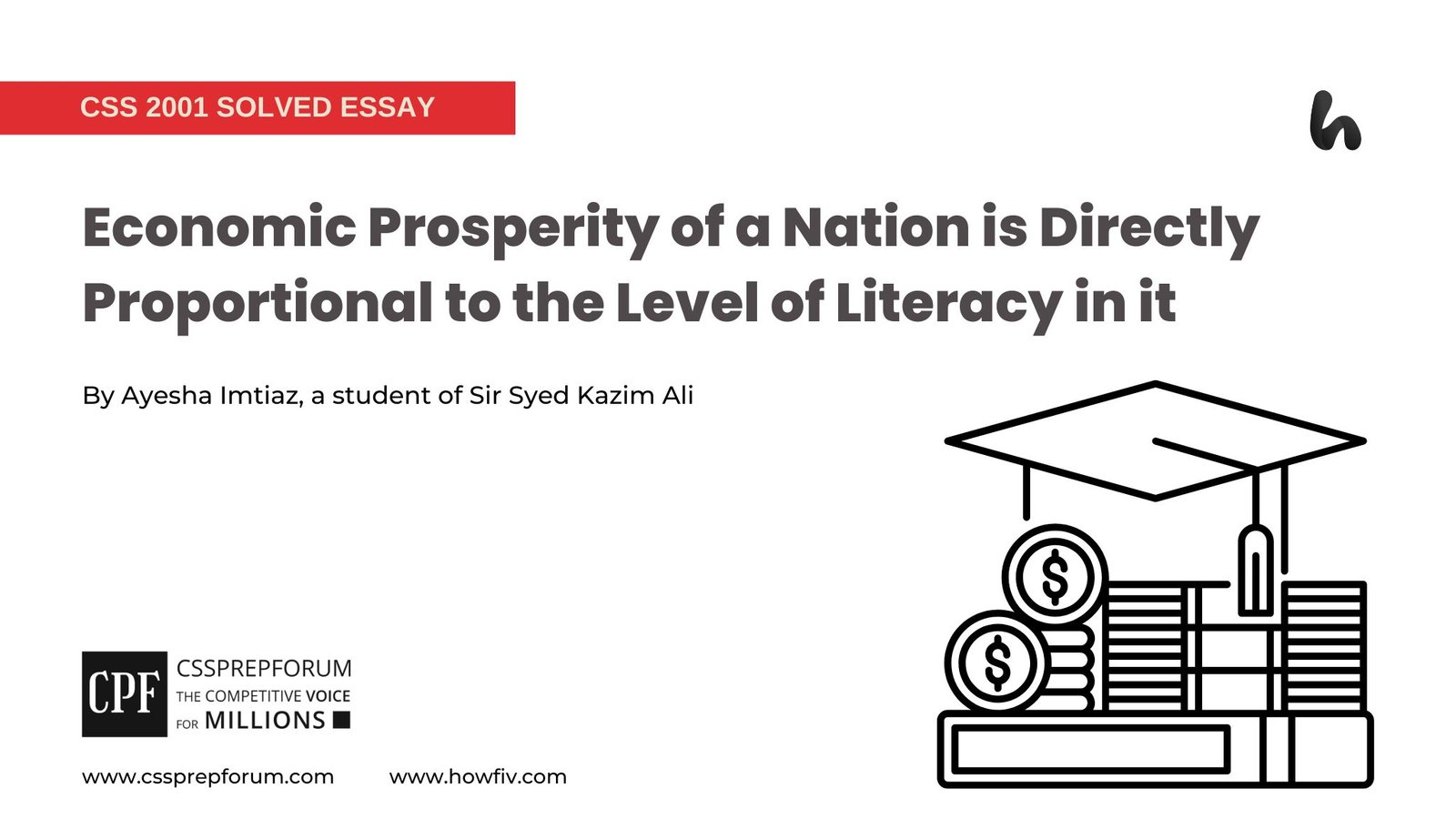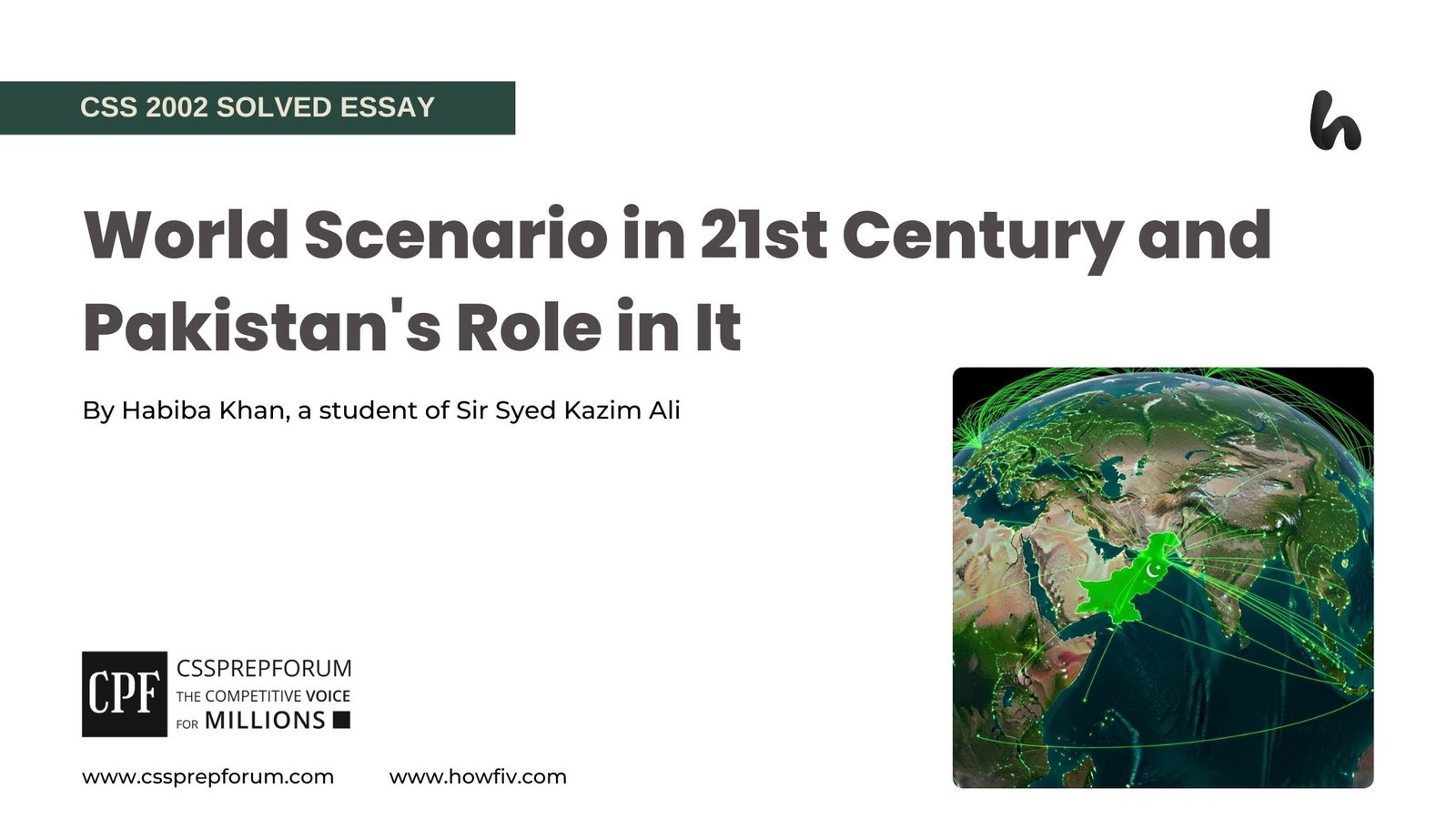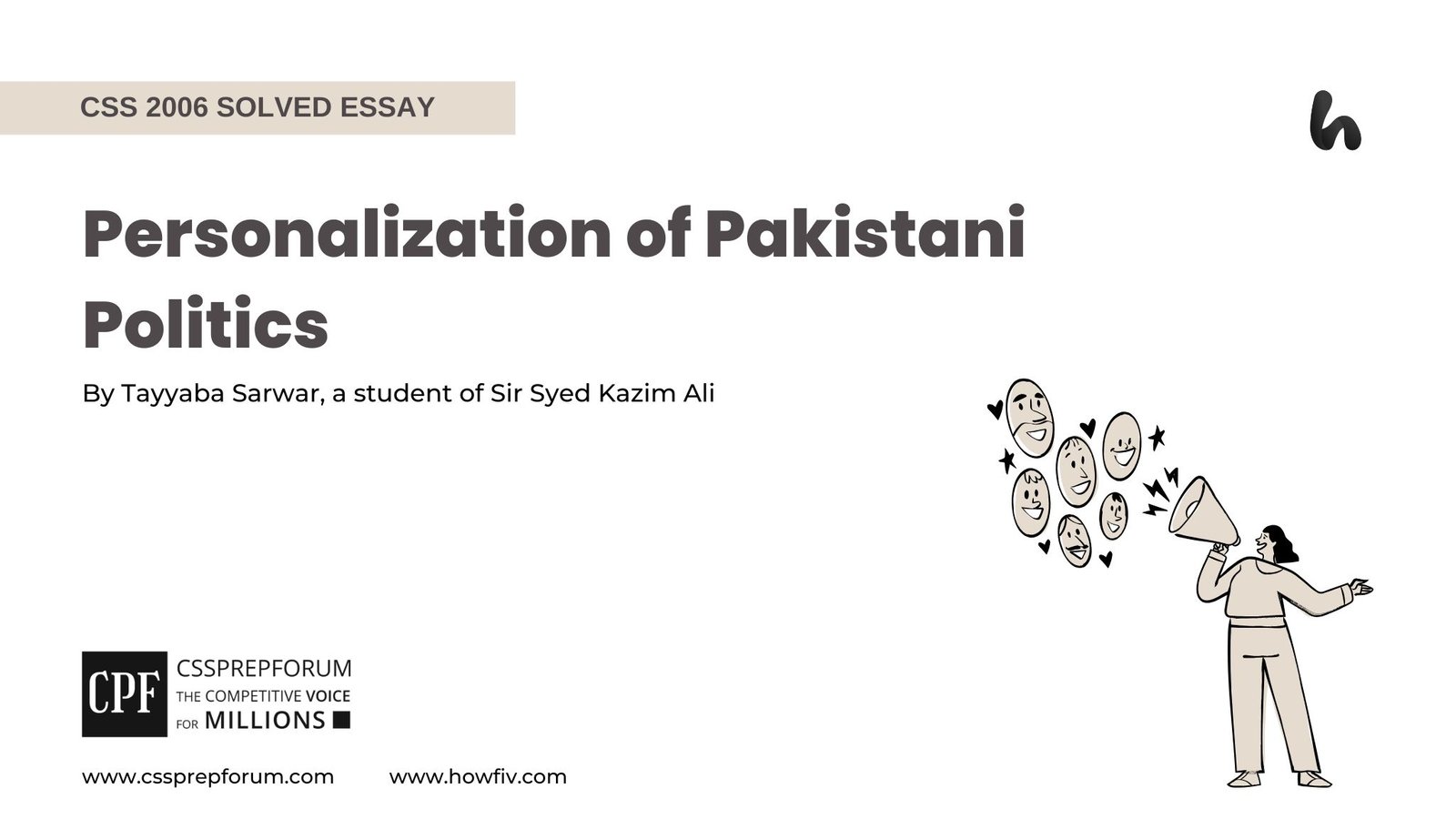CSS & PMS Pakistan Affairs | The Struggle to Define Pakistan’s Ideological Identity – Part 1
The following article for CSS & PMS Pakistan Affairs is written by Miss Iqra Ali, Top Pakistan Affairs Coach. She learnt writing from Sir Syed Kazim Ali, Pakistan’s best CSS and PMS English essay and precis teacher with the highest success rate of his students. This solved question is attempted on the pattern taught by Sir to his students, scoring the highest marks in compulsory and optional subjects for years.

Introduction
Pakistan, a state founded in the name of an ideology, has grappled since its inception with defining the appropriate role of Islam in governance and national identity. Despite Islam’s adaptability as a comprehensive and timeless ethical framework, its application in Pakistan has often become a source of contention and instability. Rather than integrating Islamic principles in their true spirit, successive political regimes have routinely instrumentalized religion to serve narrow political agendas. From Ayub Khan’s modernist manipulation of religious narratives to delegitimize Fatima Jinnah’s leadership, to General Zia-ul-Haq’s aggressive Islamization project, religion has been repeatedly politicized rather than authentically implemented. This detailed article, drawing critically upon Ziad Haider’s writing, “The Ideological Struggle for Pakistan,” along with scholarly articles and analysis, examines the chronological trajectory of Pakistan’s political regimes and their use of Islam in statecraft. To make it clear and more helpful for students, the topic may contain more than one parts; the links of other parts are attached in the end of this article.
The Ambiguity of Pakistan’s Founding Idea
In colonial India, Muslim political identity was far from monolithic; rather, it was shaped by competing ideological currents within the Muslim community. Two dominant intellectual traditions emerged
- The Aligarh School of thought, spearheaded by Sir Syed Ahmad Khan, advocated a synthesis between Western modernity and Islamic identity, encouraging Muslims to acquire English education and cooperate with the British for socio-political uplift.
- The Deobandi School of thought, grounded in traditional Islamic scholarship, rejected Western influence and sought to preserve Islamic orthodoxy and Jihad by reinforcing religious education and opposing colonial cultural hegemony.
These ideological differences contributed to the fragmentation of Muslim political responses to British rule. Ayesha Jalal in her book, “Partisans of Allah” writes, the 19th-century jihad led by Sayyid Ahmad of Rae Bareli against the Sikh Empire served as a formative model for later uses of Islamic militancy by the Pakistani state. Sayyid Ahmad’s campaign was not merely a religious rebellion but an attempt to construct an Islamic order grounded in Sharia, offering a precedent for linking territorial sovereignty with religious legitimacy. She notes,
“Balakot’s association with the idea and practice of jihad in South Asia was reinforced in the 1990s, when militant groups set up training camps in its environs… For these militants, Sayyid Ahmad and Shah Ismail are great heroes, whose jihad their admirers wish to emulate, to redress what they perceive as current injustices.”
Partisans of Allah, Ayesha Jalal
As the independence movement gained momentum, three broad streams of Muslim political thought crystallized.
- First, Congress-affiliated Muslims endorsed territorial nationalism, believing in a united India irrespective of religious differences.
- Second, Islamic religious parties, such as Jamiat Ulema-e-Hind, opposed the partition on theological grounds, arguing that it would fracture the global Muslim Ummah, yet paradoxically shared the Muslim League’s concerns over Hindu majoritarianism.
- Third, the All-India Muslim League, under Muhammad Ali Jinnah’s leadership, asserted that Muslims constituted a distinct cultural and political nation, which required safeguards and eventually a separate homeland.
Jinnah, although personally secular, strategically deployed Islamic symbolism to forge cohesion among India’s diverse and often divided Muslim communities.
“Jinnah’s invocation of Islam was not a commitment to theocracy but a deliberately vague, rhetorical tool to maintain unity among Muslim constituencies with varying aspirations. Jinnah’s intentionally obscure cry for ‘Pakistan’ was contrived to meet this requirement.”
Ayesha Jalal
Thus, Islam’s political utility lay not in its doctrinal imposition, but in its ability to rally disparate Muslim voices under a singular ideological banner in the final years of colonial rule.
Independence and Jinnah’s Ambiguous Legacy
Despite his instrumental use of Islamic rhetoric during the Pakistan Movement, Jinnah’s post-independence vision appeared to advocate a secular, civic nationalism. His landmark speech on August 11, 1947, delivered before the Constituent Assembly of Pakistan, emphasized that religion would be a private affair, stating,
“You are free; you are free to go to your temples… to your mosques… You may belong to any religion or caste or creed; that has nothing to do with the business of the state.”
Quaid-e-Azam
“Jinnah left the Home Rule League and the Congress after Gandhi took them over because he strongly disapproved of the introduction of religion into politics by Gandhi, and because he disapproved equally strongly of unconstitutional means to secure swaraj.”
H.M. Seervai, Legend and Reality
“Jinnah made it clear, however, that he had no intention of playing the role of an Islamic Khalifah. As Pakistan’s governor-general, he intended to see to it that all its citizens, irrespective of religious or cultural orientation, were, politically and before the law, similar and equal.”
Pakistan in the Twentieth Century — A Political History by Lawrence Ziring.
It is the articulation of a pluralistic and secular national identity, signaling an aspiration to build Pakistan as a modern state inclusive of all religious communities. However, this vision was soon marginalized in official historiography. Key segments of the speech were deliberately omitted from school textbooks and state records. As depicted by Rubina Anjum in her article published in the Journal of Research and Reflections in Education, “Even Jinnah was mischaracterized in the textbooks as an orthodox Muslim.”Thus, the state controlled curricula gradually began to present Jinnah as an advocate of a theocratic state, a stark revision of his nuanced and secular message. This historical sanitization points to an early ideological contestation in Pakistan’s statecraft between Jinnah’s inclusive civic vision and the rising pressure to define Pakistan in overtly Islamic terms.
Objective Resolution and Institutionalization of Ideology
The ideological ambiguity left by Jinnah’s death in 1948 was soon replaced by an explicit linkage between Islam and statecraft through the passage of the Objectives Resolution in March 1949, spearheaded by the first Prime Minister Liaquat Ali Khan. Although the resolution sought to present a compromise between Islamic and democratic ideals, it was Pakistan’s first constitutional step away from civic secularism and toward the institutionalization of Islam in governance.
The Article 2(A) of the Objective Resolution explains,
“Whereas sovereignty over the entire universe belongs to Allah Almighty alone and the authority which He has delegated to the State of Pakistan, through its people for being exercised within the limits prescribed by Him is a sacred trust”
It further pledges,
“The Muslims of Pakistan shall be enabled to order their lives in accordance with the teachings and requirements of Islam as set out in the Holy Qur’an and Sunnah”
The same article included promises of “Freedom, equality, tolerance and social justice” for all citizens regardless of faith, its Islamic framing diluted secular guarantees, leading critics to view it as a watershed moment that compromised Jinnah’s secular vision. Out of all members, all non-Muslim members voted against it, andevery proposed amendment by minorities was rejected.
“There is no place for religion in the state… the state religion is a dangerous principle… the words ‘equal rights as enunciated by Islam’ are … a camouflage. It is only a hoax to us, non‑Muslims.”
Sris Chandra Chattopadhyaya, a non-Muslim member representing East Pakistan
Dr. Juliana Usman and prof. Dr. Sameena Saeed have critically analysed the controversial status of objective resolution in the form of article 2A in the constitutional history of Pakistan in their thorough research published in the Journal of Internatoinal Relations where they quoted various other scholars backing their stance.[9]Likewise, the renowned authors like I. H. Qureshi and Ayesha Jalal have argued that the Resolution opened the door to majoritarian religious nationalism, alienating religious minorities and eventually legitimizing sectarian interpretations of Islam.
By aligning democracy with “Islamic principles,” the objective resolution has set a precedent for future constitutional articles and ordinances, including Article 2 of the 1973 Constitution declaring Islam as the state religion, and the creation of bodies like the Council of Islamic Ideology, that entrenched religion into legal, educational, and political domains. Thus, what began as an attempt at ideological cohesion became the very fault line that fostered exclusion, politicization of religion, and religiously framed authoritarianism in the decades to come.
Early Power Consolidation through Political Islam
Following the passage of the Objectives Resolution in 1949, the role of Islam in Pakistan’s statecraft expanded beyond symbolic association into a mechanism for internal political consolidation. The state began actively using Islamic ideology to delegitimize dissent, regulate religious boundaries, and forge a cohesive national identity in a multi-ethnic, multi-sectarian polity. However, already facing profound ethnic, linguistic, and regional fissures, particularly between East and West Pakistan, Islam was used by the state-elite to suppress pluralistic claims and override ethnic diversity and created a framework where dissent was delegitimized through theological framing rather than democratic debate. A prominent example was the 1953 anti-Ahmadi riots in Lahore, which marked the first major state-sanctioned effort to regulate religious identity. The Punjab disturbances, instigated by Majlis-e-Ahrar and later supported by segments of Jamaat-e-Islami and other right-wing clerics, demanded that Ahmadis be declared non-Muslims and removed from key government posts, including that of Foreign Minister Zafarullah Khan. The state responded not only with military force (the first time martial law was declared in Lahore) but also by beginning a process of formally defining religious boundaries through the Munir Report (1954), which notably concluded,
“If the ulema of different sects are to be trusted with defining who is a Muslim, the result will be that no two Muslims will be left in the country.”
Furthermore, as religious parties like the Jamaat-e-Islami began to assert more influence, an increasingly narrow and politicized version of Islam started entrenching in the country. Instead of resolving ideological ambiguity, the post-Resolution period marked the beginning of state-sponsored efforts to define “acceptable” Islam, a move that would haunt Pakistan’s internal cohesion for decades.
Islam and Pakistan’s Early External Relations
As Far as role of Ideology in the foreign relations of Pakistan is concerned, it was strategically employed to shape and justify its external relations, particularly with India. Nowhere was this more evident than in the Kashmir conflict of 1947–48, which was framed not merely as a territorial dispute but as a religiously sanctioned jihad. Pakistan’s leadership is alleged to mobilize tribal fighters from the North-West Frontier Province, rallying them with clerical fatwas that cast the incursion into Kashmir as a sacred duty to defend Muslim brethren. According to British sources, Governor Sir George Cunningham reported a widespread call for “jehad against Kashmir” in Hazara by October 1947. Scholars and former officers confirm that the conflict was framed in religious terms, many joined the campaign believing it was their duty because “Islam [was] in danger”. This framing imbued the conflict with religious legitimacy, facilitating mass mobilization while consolidating domestic unity under the banner of Islam. More significantly, this early use of religion to justify irregular warfare laid the ideological and operational foundation for Pakistan’s later doctrine of proxy jihad, a pattern that would reappear in the 1965 and 1990s Kashmir insurgencies, and in its support for the Taliban in Afghanistan. In this way, Islamic ideology became not just a domestic unifier but also a strategic asset in Pakistan’s external engagements, entrenching a pattern in which religion was used to legitimize state-sponsored non-state actors to achieve geopolitical goals under the guise of pan-Islamic solidarity.
Pakistan’s Eagerness in Constructing a Muslim International Identity
In addition to leveraging Islamic rhetoric in its internal consolidation and Kashmir policy, Pakistan also sought to project itself internationally as the vanguard of the Muslim world. In July 1949, the head of the Pakistan Muslim League, Choudhry Khaliquzzaman, called for the creation of a united “Islamistan.” For this purpose, he, on his visit to Middle East, put forward this idea before the Arab leaders, and he said when asked for their response by media,
“There was a general appreciation … but there are different views about the means and methods that should be pursued for realising it. During my tour, I tried to find whether there is in the Arab world a majority opinion for the establishment of Islamistan. The peoples of the Middle East have seriously started discussing the idea and ways for the grouping of Middle East States.”
Likewise, in December 1949, Pakistan hosted the first international Islamic conference in Karachi, a strategic move aimed at consolidating its identity as a leader of the Muslim Ummah. Such initiatives were not merely symbolic; they reflected the state’s post-colonial anxiety to differentiate itself from India, not only territorially but ideologically as a Muslim-majority state with global relevance. During the same period, Pakistan was simultaneously engaged in bilateral negotiations with India over contentious issues like Kashmir, evacuee property, and the Punjab water dispute, particularly after India temporarily cut off water flows in April 1948. These dual tracks of Islamic solidarity abroad and tense regional diplomacy reveal how religion and ideology began shaping not just domestic narratives but also the external orientation of the Pakistani state from its formative years.
Bottom Line
In sum, the early years of Pakistan witnessed a strategic but fraught use of Islamic ideology to define national identity, suppress dissent, and consolidate state power. These foundational choices laid the groundwork for future ideological entanglements both at home and abroad. The article is continued in the next parts.

For Reading More Parts of the Series
| The Struggle to Define Pakistan’s Ideological Identity – Part 1 |
| The Struggle to Define Pakistan’s Ideological Identity – Part 2 |
| The Struggle to Define Pakistan’s Ideological Identity – Part 3 |
| The Struggle to Define Pakistan’s Ideological Identity – Part 4 |
| The Struggle to Define Pakistan’s Ideological Identity – Part 5 |
CSS Solved Past Papers’ Essays
Looking for the last ten years of CSS and PMS Solved Essays and want to know how Sir Kazim’s students write and score the highest marks in the essays’ papers? Then, click on the CSS Solved Essays to start reading them.
CSS Solved Essays
CSS Solved Islamiyat Past Papers
Want to read the last ten years’ Islamiyat Solved Past Papers to learn how to attempt them and to score high? Let’s click on the link below to read them all freely. All past papers have been solved by Pakistan’s top CSS Islamiyat coach having the highest score of their students.
CSS Solved Islamiyat
CSS Solved General Science & Ability Past Papers
Want to read the last ten years’ General Science & Ability Solved Past Papers to learn how to attempt them and to score high? Let’s click on the link below to read them all freely. All past papers have been solved by Pakistan’s top CSS GSA coaches having the highest score of their students.
CSS Solved General Science & Ability
CSS Solved Pakistan Affairs Past Papers
Want to read the last fifteen years’ Pakistan Affairs Solved Past Papers to learn how to attempt them and to score high? Let’s click on the link below to read them all freely. All past papers have been solved by Pakistan’s top CSS Pakistan Affairs coaches having the highest score of their students.
CSS Solved Pakistan Affairs












